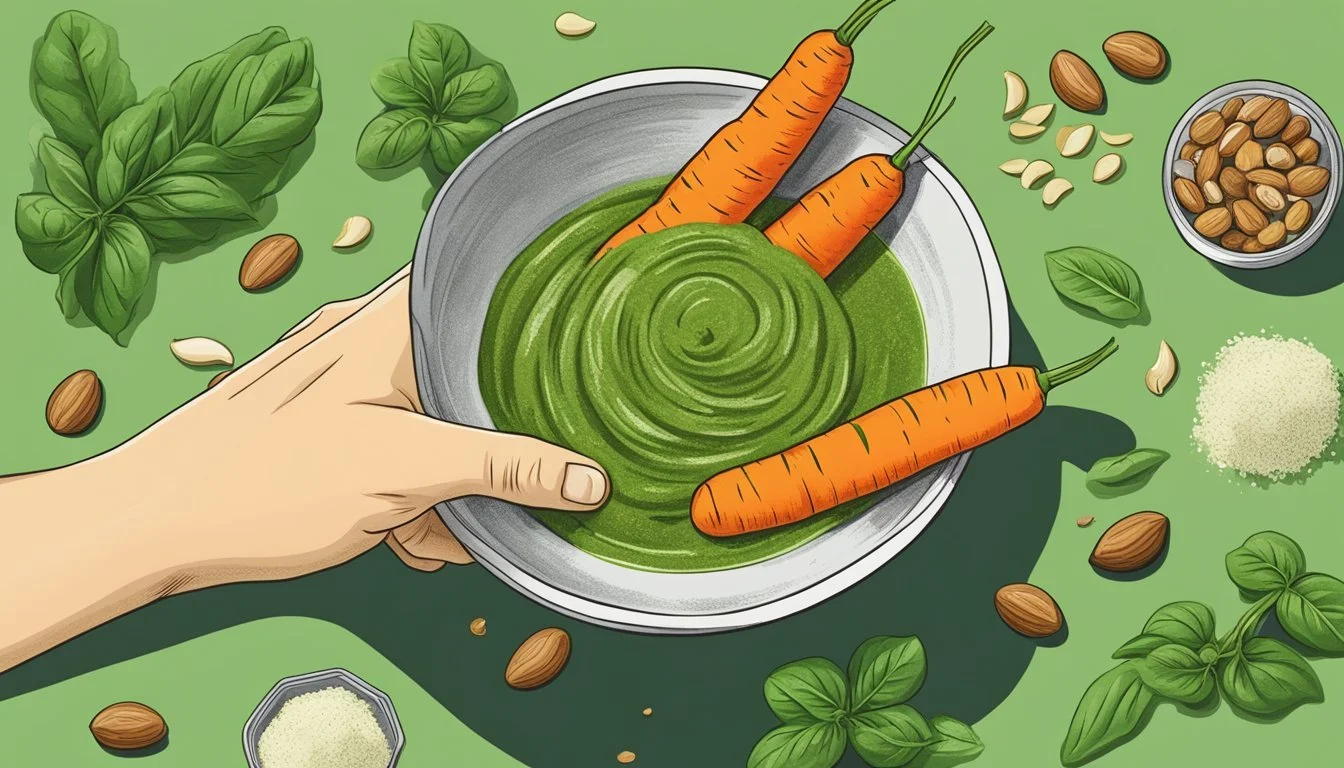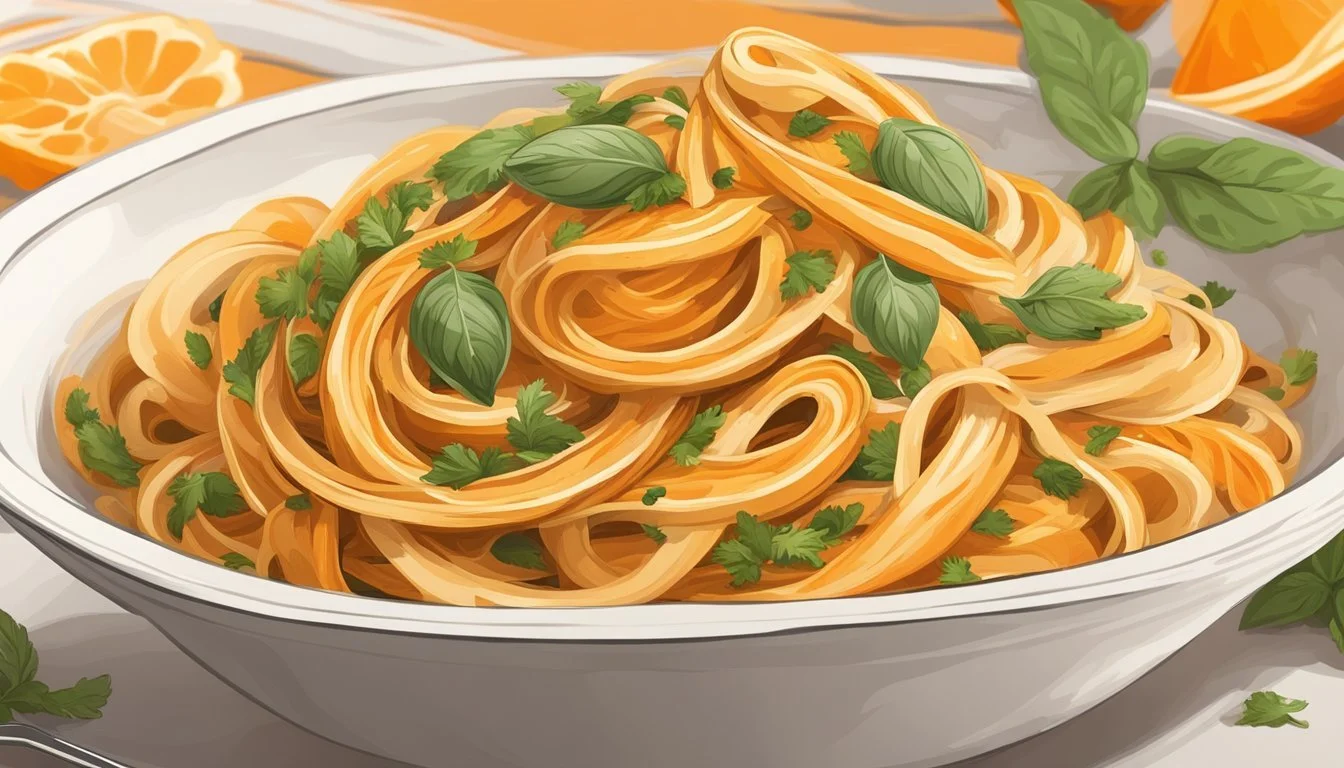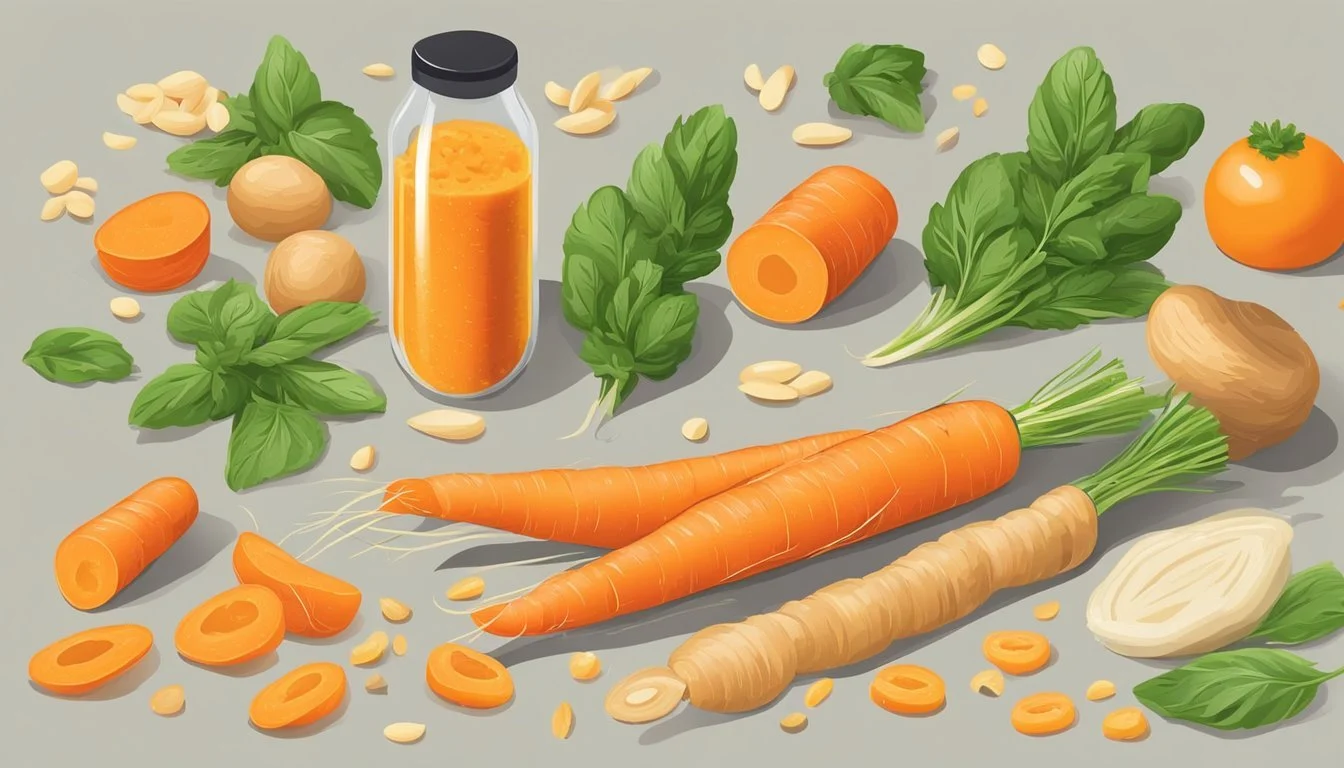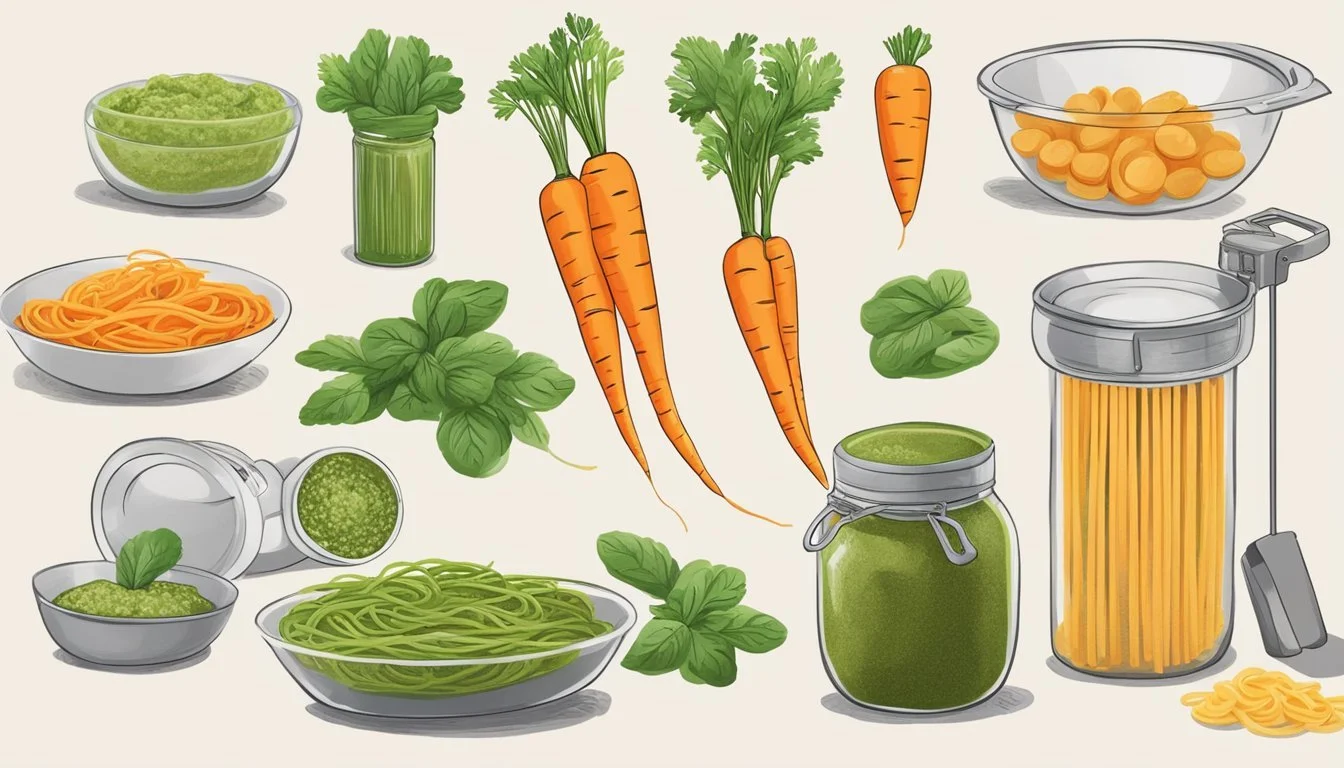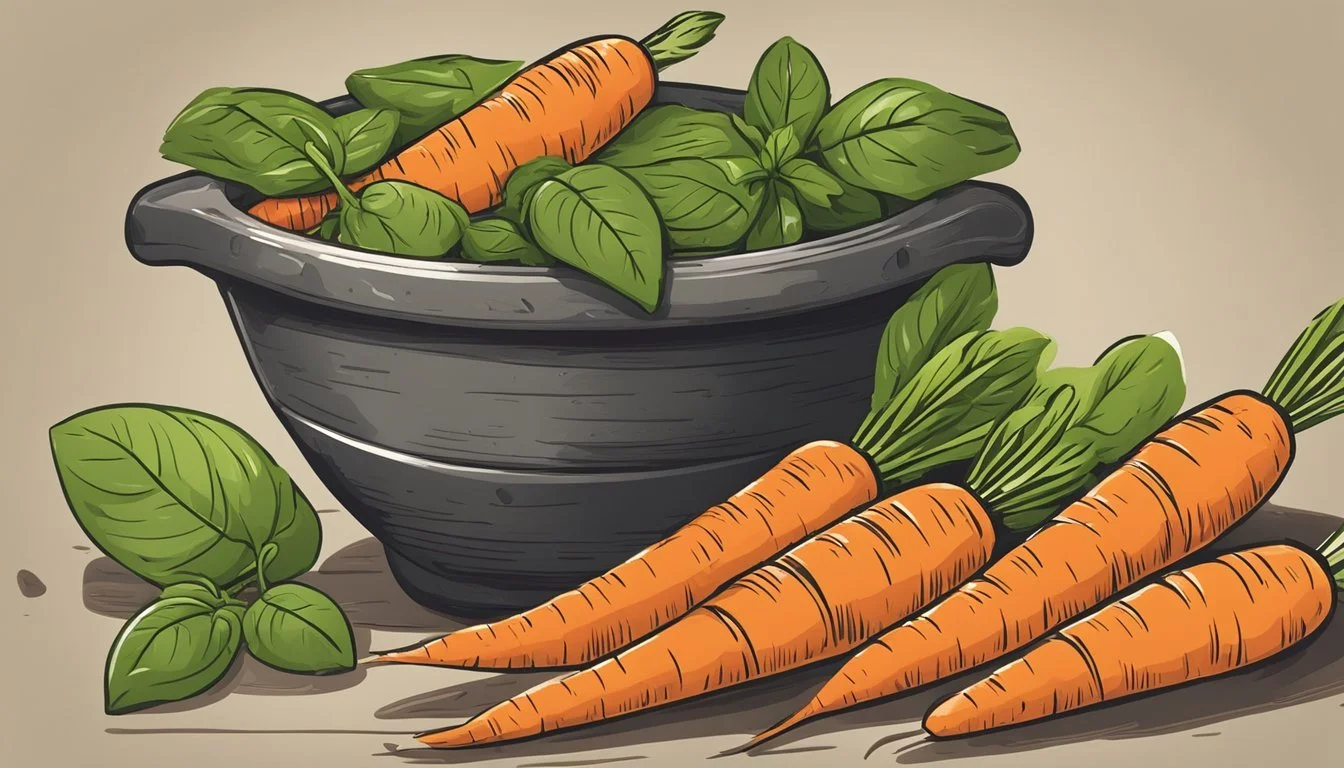Carrot Peel Pesto
The Ultimate Guide to a Unique and Flavorful Pasta Sauce
Carrot Peel Pesto transforms the often-discarded skins of carrots into a flavorful, sweet, and earthy sauce perfect for dressing up pasta (What wine goes well with pasta?) dishes. With sustainability in kitchen practices gaining traction, this resourceful use of carrot peels not only minimizes food waste but also introduces a novel twist to traditional pesto. The natural sweetness of carrot peels, when combined with the robust flavors of garlic, cheese, and nuts (What wine goes well with nuts?), creates a harmonious blend that is both pleasing to the palate and beneficial for the planet.
The creation of Carrot Peel Pesto involves a simple process of blending the peels with classic pesto ingredients like nuts—typically walnuts or pine nuts—and a hard cheese such as Parmesan. The pesto's texture and flavor depth can be adjusted to the chef's preference, offering versatility from a chunkier sauce to a smooth, creamy consistency. Olive oil serves as the binder that holds all components together, yielding a sauce that is as delightful in taste as it is in appearance.
As more home cooks and chefs alike lean into creative and waste-reducing cooking methods, Carrot Peel Pesto stands out as a prime example of how ingenuity in the kitchen can lead to delectable and eco-friendly outcomes. This pasta sauce not only brings a vibrant color and a unique taste to the table but also contributes to a more sustainable culinary practice, making it an excellent choice for the modern eco-conscious gourmand.
What You Need to Know About Carrot Peel Pesto
Carrot peel pesto turns often-discarded carrot peels into a vibrant, nutrient-rich sauce. Enriched with vitamin A, vitamin C, potassium, fiber, calcium, and iron, this pasta sauce is not just delicious but also beneficial for health.
To create this sauce, one needs carrot peels, which provide an earthy and sweet undertone. The green tops of carrots, usually thrown away, are full of flavor and can be used in pesto too. They work alongside traditional pesto ingredients such as garlic, salt, pepper, and lemon juice to enhance the taste.
The process begins with a food processor or blender—critical tools for achieving the right texture. The carrot peels and tops are combined with these fresh ingredients:
Olive oil: A cornerstone of pesto, for a smooth consistency and healthy fats.
Garlic: To add a sharp and aromatic flavor depth.
Nuts: Often walnuts or pine nuts, though substitutes like cashews are used.
Cheese: A hard cheese like Parmesan brings a salty, umami kick.
Here is a simple structure of the ingredients and their proportions:
Ingredients Quantity Carrot peels and tops 1 cup Garlic 2 cloves Nuts 1/3 cup Grated hard cheese 1/4 cup Olive oil 1/2 cup Lemon juice To taste Salt & pepper To taste
One combines the ingredients in the processor, pulsing to a fine chop before blending with olive oil into a creamy mixture. Lemon juice is added for a tangy finish. Carrot pesto pairs wonderfully with pasta but can also be used as a spread or dip.
This pesto variation not only reduces food waste but provides a new, inventive way to enjoy the full potential of carrots.
Health Benefits of Carrot Pesto
Carrot pesto not only brings a unique sweet and earthy flavor to your pasta dishes (What wine goes well with pasta dishes?) but also incorporates a variety of nutrients beneficial to one's health. This savory sauce combines carrots, rich in vitamins, with heart-healthy olive oil, ingredients such as garlic, and Parmesan cheese for added calcium.
Nutritional Profile of Carrots
Carrots are a robust source of vitamin A, which is essential for eye health and immune function. They also contain vitamin C, potassium, and fiber. Vitamin C is a powerful antioxidant that supports the immune system, potassium is crucial for heart health, and fiber aids in digestion.
Nutrient Benefit Vitamin A Supports eye health Vitamin C Antioxidant; boosts immunity Potassium Promotes heart health Fiber Enhances digestive health
Benefits of Olive Oil and Garlic
Olive oil is renowned for its heart-healthy properties, primarily due to its monounsaturated fats that can reduce the risk of heart disease. It also contains antioxidants which combat inflammation. Garlic is not only a flavorful addition but also boasts its own health benefits, including potentially reducing blood pressure and cholesterol levels.
Ingredient Benefit Olive oil Reduces heart disease risk; fights inflammation Garlic May lower blood pressure and cholesterol
Parmesan Cheese: A Calcium Boost
Parmesan cheese is an excellent source of calcium and protein, both necessary for bone health. It also provides iron which is vital for transporting oxygen in the blood. Incorporating Parmesan into carrot pesto adds a salty, umami depth while contributing to the sauce’s nutritional value.
Nutrient Benefit Calcium Strengthens bones Protein Aids in muscle repair Iron Essential for oxygen transport
Preparation and Cooking Tips
When preparing Carrot Peel Pesto, selecting quality ingredients and employing the right techniques are crucial for creating a delightful sauce. This section will provide practical tips to ensure your pesto turns out flavorful and has a perfect, creamy consistency.
Choosing the Right Ingredients
Carrots: Opt for fresh, organic carrots with vibrant color and firm texture. The peels pack a lot of flavors and nutrients, so it's important they come from well-washed carrots.
Olive Oil: A high-quality extra virgin olive oil will contribute to a silky and rich body for the pesto. Its fruity notes complement the sweetness of the carrots.
Garlic: Fresh garlic cloves are essential for a robust flavor; adjust quantity based on preference but generally one to two cloves will suffice.
Salt and Pepper: Sea salt can enhance the natural flavors of the ingredients, while freshly ground black pepper adds a subtle warmth. Adjust both to taste.
Lemon Juice: Adds a brightness that balances the earthiness of the carrots. Freshly squeezed lemon juice is preferred.
Using a Food Processor or Blender
Food Processor/Blender: A food processor or high-powered blender is ideal for creating a smooth pesto. It should be capable of fine chopping as well as blending to a smooth texture.
Technique: Start with pulsing the dry ingredients to achieve a coarse mixture before streaming in olive oil slowly for emulsification. Scrape down the sides as necessary.
Achieving the Perfect Texture
Creamy Consistency: To attain a creamy texture without diluting flavor, add olive oil gradually while blending until the desired consistency is reached. Do not over-process as it can heat the ingredients and alter the flavors.
Adjustments: If the pesto is too thick, thin it out with small amounts of water until it reaches the perfect consistency. For a vegan or gluten-free version, consider alternatives like nutritional yeast or gluten-free pasta to pair with the pesto.
Perfecting Your Carrot Peel Pesto Recipe
Creating the perfect Carrot Peel Pesto entails a blend of sweet carrot peels and earthy carrot tops, transformed into a flavorful pasta sauce that's both healthy and versatile. Here are the steps to perfect it:
Ingredients Preparation:
Carrot peels, from organically grown produce, ensure a sweet base.
Fresh carrot tops, thoroughly rinsed to remove any dirt.
High-quality olive oil for a smooth emulsion.
Freshly grated Parmesan cheese, or vegan cheese for a dairy-free option.
Seasoning:
Fresh garlic, minced for a pungent kick.
Sea salt and freshly ground black pepper, to enhance flavors.
Lemon juice, freshly squeezed to add a zesty note.
Instructions:
Base: In a food processor or blender, combine the carrot peels and tops until finely chopped.
Step Action Ingredient 1 Pulse Carrot Peels & Tops
Additions: Introduce garlic, salt, and pepper to the mixture, pulsing again to combine.
Step Action Ingredient 2 Pulse Garlic, Salt, Pepper
Emulsification: While the appliance is running, drizzle in olive oil gradually to create the desired consistency.
Step Action Ingredient 3 Drizzle Olive Oil
Final Touch: Blend in the Parmesan cheese and lemon juice, adjusting these to taste.
Step Action Ingredient 4 Mix Parmesan, Lemon Juice
For those adhering to gluten-free diets, serve the pesto over gluten-free pasta, incorporating it into your meal plan as a go-to sauce that's both appetizing and nourishing. This carrot-based pesto recipe delivers a distinctive twist on the traditional sauce, while maintaining an appealing texture and depth of flavor.
Storing and Preserving Your Pesto
Proper storage of carrot peel pesto is vital to maintain its sweet and earthy flavor and extend its shelf life. Whether it’s freshly made or leftovers, ensuring carrot pesto is stored correctly will preserve its qualities and reduce food waste.
Short-Term Storage Solutions
For short-term preservation of carrot peel pesto, it is important to store it in the refrigerator. Immediate refrigeration is necessary to keep the flavors of the olive oil, parmesan cheese, and carrot peels intact.
First use: Immediately after preparing the pesto, place it in an airtight container.
To reduce exposure to air: Cover the pesto with a thin film of olive oil.
Refrigeration time: Consume refrigerated pesto within 5 days for the best quality.
Long-Term Freezing Methods
If you have a surplus of carrot top pesto and wish to preserve it for an extended period, freezing is an ideal option.
Pre-freezing preparation: Portion pesto into ice cube trays, smoothing the tops flat.
Olive oil: Drizzle a thin layer of olive oil over the cubes to create an air-tight seal.
Freezing process: Once frozen, transfer pesto cubes to freezer bags.
Labeling is key: Clearly mark the bags with the date of freezing.
Freezer shelf life: Properly stored, frozen pesto can be used for up to 3 months for optimal taste.
By adhering to these storage methods, the carrot pesto’s vibrant flavor and nutritional quality can be preserved effectively for both immediate and future needs.
Creative Uses for Carrot Peel Pesto
Carrot peel pesto, with its sweet and earthy flavor profile, is a versatile condiment that can enhance various dishes. Below, explore the array of culinary creations that can be transformed with this unique sauce.
As a Unique Pasta Sauce
Carrot peel pesto can be seamlessly integrated into pasta dishes, providing a delightful twist to classic recipes. Whether it's drizzled over gluten-free fusilli for those with dietary restrictions or served with linguine for a more traditional approach, the pesto adds a layer of complexity to the dish with its nuanced sweet and savory notes.
Pasta Type:
Gluten-Free Options: Fusilli, Rotini
Traditional Pasta: Linguine, Rotini
Beyond Pasta: Sandwiches and Dips
Moving beyond pasta, carrot peel pesto can elevate the everyday sandwich to a gourmet experience. It can be spread on artisan bread or a simple vegan wrap to add vibrancy and depth. Additionally, when used as a dip, it pairs well with a tray of crisp vegetables such as broccoli, cauliflower, and asparagus or with a side salad, offering a creamy and rich texture.
Sandwich Spread:
Vegan wraps
Bold-flavored cheeses
Vegetable Dip:
Broccoli, Cauliflower, Asparagus
Side Salad with a light, tangy dressing
Innovative Pairings and Meal Plans
For those looking to incorporate carrot peel pesto into a well-crafted meal plan, consider using it as a dressing for grain bowls featuring quinoa or rice. The pesto can also be matched with sweet potatoes and parsnips, whose natural sweetness complements the pesto's flavors. In a creamy pasta, integrating carrot pesto can offer a lush, velvety sauce base, perfect for a hearty dinner.
Grain Bowl Dressing:
Quinoa, Brown Rice, Whole Grains
Sweet Potatoes, Parsnips
Creamy Pasta Component:
Use as a base for adding spices and extra creaminess
Adapting the Recipe for Dietary Restrictions
Carrot peel pesto can be easily modified to suit various dietary needs, ensuring everyone can enjoy this unique sauce. By selecting specific ingredients, both individuals with gluten sensitivities and those following a vegan diet can relish this flavorful pesto.
Making Carrot Pesto Gluten-Free
For those avoiding gluten, the primary concern in carrot peel pesto is the pasta it's served with. To adapt the recipe, one should opt for gluten-free pasta, which is readily available in most supermarkets. They come in various shapes and sizes, made from ingredients like rice, corn, and quinoa. It's essential to ensure that all other ingredients, such as cheeses and seasonings, are certified gluten-free to avoid cross-contamination.
Choose gluten-free pasta: rice pasta, corn pasta, quinoa pasta
Check labels: ensure all ingredients, including garnishes, are gluten-free
Creating a Vegan Version
To make carrot peel pesto suitable for vegans, dairy cheese must be replaced. Vegan parmesan cheese is an excellent substitute, often made from cashews, nutritional yeast, and seasonings to mimic the umami flavor profile of traditional parmesan. For the pesto's creamy texture, one may replace traditional cheese with a blend of nutritional yeast and either raw cashews or pine nuts, both of which give a rich and satisfying mouthfeel.
Vegan parmesan cheese: blend of cashews, nutritional yeast, garlic powder, and salt
Non-dairy alternatives: use nutritional yeast or vegan cheese products to achieve the desired consistency
By mindfully selecting gluten-free and vegan-friendly ingredients, individuals with dietary restrictions don't have to miss out on the delightful experience of carrot peel pesto.
Environmental Impact and Food Ethics
Utilizing Carrot Peel Pesto as an inventive pasta sauce underscores the potential for both reducing food waste and supporting plant-based diets, aligning cooking practices with environmental stewardship.
Reducing Kitchen Food Waste
One can significantly reduce kitchen food waste by repurposing carrot peels and greens, which are often thrown away, to create a nutrient-rich pesto. Instead of discarding these byproducts, turning them into a sauce not only minimizes waste but also makes use of their sweet, earthy flavors. (What wine goes well with earthy flavors?) This approach can extend to other vegetables, where parts like peas and beans shells can be transformed into a hearty vegetable stock.
Incorporation in Recipes:
Carrot tops and carrot greens
Supporting Plant-Based Eating
Carrot Peel Pesto champions plant-based eating by using vegetable byproducts, thus lowering reliance on animal products. For a creamy pesto texture without cheese, one can blend in white beans or cashews, both plant-based alternatives with lower environmental footprints compared to dairy. Adding parsley adds freshness and complexity to the flavor profile.
Plant-Based Alternatives:
White beans or cashews for creaminess
Parsley for enhanced flavor
Sustainable Cooking Practices
Sustainable cooking involves thoughtful meal planning and ingredient selection. Designing a meal plan that reutilizes ingredients like carrot greens and other vegetable remains in multiple recipes throughout the week can decrease grocery shopping frequency and food spoilage. Committing to such practices requires a conscientious effort to adjust typical shopping habits and explore versatile uses of all parts of produce.
Practices to Consider:
Use every part of the vegetable
Plan meals to incorporate leftover ingredients
Frequently Asked Questions About Carrot Pesto
What is Carrot Peel Pesto?
Carrot Peel Pesto is a pasta sauce that utilizes the often discarded peels of carrots. It offers a sweet, earthy flavor and can also be made using carrot tops for a waste-free kitchen solution.
Is Carrot Pesto vegan and gluten-free?
The traditional pesto recipe includes cheese; however, carrot pesto can easily be made vegan by substituting cheese with nutritional yeast or a vegan cheese alternative. By using gluten-free pasta or as a condiment, carrot pesto can be part of a gluten-free diet.
How is Carrot Pesto prepared?
Combine carrot peels or tops, nuts (like walnuts or pine nuts), garlic, and salt in a blender. Pulse until coarsely chopped, then add extra virgin olive oil while blending to achieve a creamy consistency.
Can I make Carrot Pesto creamy without dairy?
Yes, by incorporating soaked nuts or seeds, you can create a creamy texture without dairy. Adjust the oil or add a bit of water to reach the desired creaminess.
What does Carrot Pesto pair well with?
Carrot Pesto pairs beautifully with pasta, as a spread on sandwiches, or as a seasoning for roasted vegetables. (What wine goes well with roasted vegetables?)
How should Carrot Pesto be stored?
Store in an airtight container in the refrigerator for up to a week. For longer storage, it can be frozen.
How many servings does this recipe make?
The serving size can vary, but typically, it yields about 1 cup, which is enough for 4 servings when used as pasta sauce.
Is this recipe easy to make?
Yes, carrot pesto is quite straightforward to prepare and requires minimal cooking skills. It's perfect for a quick, nutritious meal.
Ingredients Description Carrot Peels/Tops Utilize scraps to reduce waste and add flavor. Nuts Walnuts or pine nuts for texture and richness. Olive Oil Extra virgin for the best taste and a smooth texture. Seasoning Garlic and salt to enhance the pesto's flavor profile.
Conclusion
The creation of Carrot Peel Pesto capitalizes on the oft-discarded parts of vegetables, transforming them into a delightful pasta sauce that boasts a unique combination of sweet and earthy flavors. It is an innovative recipe that contributes to a sustainable cooking approach, ensuring minimal waste and enhancing the meal plan with a nutritious option.
One finds that the pesto pairs perfectly with a variety of pastas and serves as a versatile condiment beyond traditional uses. Carrot tops and peels are the stars, offering a rich source of vitamins and a complex flavor profile when combined with classic pesto ingredients such as nuts, cheese, and olive oil.
Key Highlights of Carrot Peel Pesto:
Utilizes leftovers effectively.
Adds an inventive twist to regular pesto.
Simple to prepare and integrate into weekly meal plans.
Confidently elevates the taste of any pasta dish.
The process is as straightforward as it is rewarding, with the pesto preparation fitting seamlessly into the cooking routine. Cooks are encouraged to embrace this recipe, which not only respects the environment by reducing waste but also provides an excellent, homemade sauce that can be adapted to individual tastes.
Should one explore the nuances of this dish, they would discover its potential to become a staple in their kitchen repertoire, aligning with both health and eco-conscious dining trends. In conclusion, Carrot Peel Pesto stands as a testament to ingenious culinary creativity, combining sustainability with the pursuit of refined, flavorful experiences.

